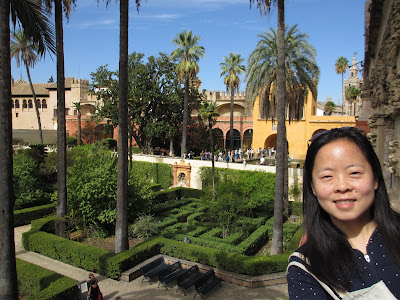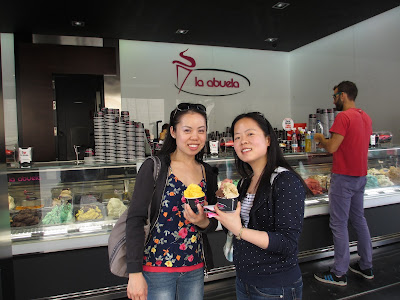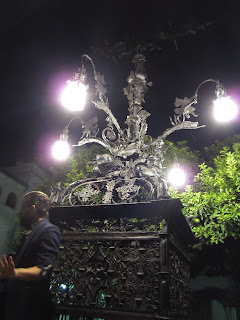10/7/2015
For me, the highlight of this whole trip is Real Alcazar,
where they filmed Dorne in Game of Thrones. The water gardens looked so lush
and dreamy, I wanted to see it for myself. Alcazar did not disappoint; if
anything, it exceeded my expectations. I loved it! Kingdom of Heaven was filmed
here, as well as Lawrence of Arabia.
 |
| Line to get into Real Alcazar. What low season? |
The castle opens at 9:30AM but since last night was a late night, we didn’t wake up in time to be there right when it opened. Shocking, I know, right? We ended up there around 10AM, and there was already a line to get in. Once we cleared security, there’s a booth where you can pick up audioguides for a steep 5 euros each. But you’re only here once, so we sucked it up and got two. If you know your Spanish history, then the audioguide will enrich your experience. But for those of us who don’t, it was not as informative as I’d hoped for. For example, who is Peter I? Who is Charles V? They don’t delve into why these monarchs are important, which would’ve been nice to know. Guess I’ll have to Google it myself.
The courtyard we entered through is gorgeous. It’s like
being transported into Aladdin, with the colorful tiles and dome-shaped column
arches. There are so many different pockets and hallways you really can get
lost—one hallway will lead into a smaller courtyard with beautiful tiled
gutters (well, they would have considered them fountains back then) trickling
water into a fountain, another will lead to a garden, and it just goes on and
on.
Amerigo Vespucci once taught in this room:
There are multiple courtyards in this labyrinth of a palace (we certainly got lost on more than one occasion!):
It was originally a palace for the Moorish kings, and is the
oldest palace still in use by royals in Europe. King Peter I of Spain had the
bedchambers converted into a series of rooms within rooms, all connected to
each other like a maze. This was how Moorish cities defended themselves back in
the day; they deliberately made their city streets narrow and maze-like so
intruders would get lost and confused. This allowed the Moors to attack strategically.
Peter I used this strategy for his main rooms because he had a lot of enemies.
His brother and mother included. He wanted to be able to run and hide in case
someone came along and tried to kill him.
The palace is decorated with mudejar tiles, which look
Moorish but are actually Christian tiles inspired by Arabic designs. By their own religious laws, Muslims
aren’t allowed to depict faces and animals on their decorative tiles, so
that’s how you know these are Christian tiles. A lot of rooms have different
animal motifs, like peacocks and birds. There’s also a “doll room” because the
carving is in the shape of a doll’s head. Creepy, I know.
Peter I’s main courtyard:
He had his bedroom on the lower floor because in the summer,
heat rises and it gets really hot here. It’s October and the weather was nice
enough for tank tops and summer dresses.
GoT three arches!
Yet another courtyard:
 |
| GoT Water Gardens |
You can really spend a whole day here. Just bring a picnic
and eat out in the gorgeous gardens, meander along the orange trees, lemon
trees (originally imported in Spain from Asia. Who knew?), and tropical
flowers.
This white building is where Jaime fights with the Sand Snakes:
 |
| Bronn and the Sand Snakes |
And this garden (on the other side of a building from the Water Gardens) looks a lot like the garden Margaery and her grandmother Olenna Tyrell connive in:
 |
| Grapes! |
 |
| Seville Orange |
You can better see now where Bronn, Jaime and the Sand Snakes fight next to:
Where Ellaria complains to Prince Doran about Jaime being in their country:
...is the yellow building you see below:
There's a tube on the top left of the yellow building that gushes water into the pond below (there's a square pond just behind the iron railing), so all around the garden, you can hear the continuous splash of water. It really is the Water Gardens!
 |
| The pond |
Unfortunately, we had to leave Alcazar to squeeze in lunch.
In total, we spent 4 hours in Alcazar and I thought that was rushing it! We
didn’t get to explore half the grounds, and some of the courtyards we had to
rush through.
 |
| La Giralda Tower |
To get to the restaurant, we went down all these twisty little streets (much smaller than the one below). Some of them you have to go in single file!
Vinerio San Telmo is another tapas restaurant I’ve been very
much looking forward to eating at. Dad ordered the Spanish tortilla. Give him eggs and
potatoes, and he’s good to go.
The real star (out of all the wonderful dishes we already
had) was the stewed oxtail filo dough eggroll:
We all loved this dish so much, we ordered another one! The oxtail was so so sooo tender, and was so flavorful, I wish I had an entire dish of it to slurp up. For someone who doesn’t like eggrolls (me), I really liked the texture of the fried filo dough. I think they only used one layer of filo, so you don’t have the layers and layers of dough.
Mom got the roasted lamb, which she really liked. She loved
the gravy too, and she never likes gravy.
If you look to the bowl dish, it's poached egg with fois gras micuit and assorted mushrooms.
I wanted to come here primarily for their foie gras with apple compote—five plump slices of pure heaven! We’re noticing that the Spanish really like big flakes of sea salt on their meat. Yesterday, at La Brunilda, the pork and foie gras had crisp flakes of sea salt on it.
We ordered the grilled Iberica pork, which was also topped
with sea salt. I never thought pork that thin would taste so good, but the chef
really knocked it out of the park. Paired with pumpkin, yum.
Don Juan statue:
We're finding out that Portugal and Spain really love their gelato. I guess because the weather's so hot?
Angel got dark chocolate and pistachio:
I got mango, which was delish! It tasted like real mango pulp instead of the chemical-tasting extract:
We’d reserved seats for the 5pm flamenco dance at Museo del
Baile Flamenco. We went in around 4:15pm and grabbed really good seats. Front
row seats.
We were lucky because right after I paid, a whole group showed up. The theater can fit 120 people, and our show was sold out. The hotel receptionist told us yesterday that the 7pm show (the one I originally wanted) was already sold out; Angel calculated this to come out to a million dollar business a year based on current ticket prices! It’s 20 euros/person, 24 euro if you want admission to the museum included. We had a 2 euro discount card, so it was 22 euro/person.
The show was good, though I guess I expected more of the
“lovers’ dance.” The female dancer had her solo, the male dancer had his, and then
they would dance together on occasion. They focused more on the music, I think,
with the singer clapping his hands to mark the rhythm.
The dancers dance so hard, their heels kick up piles of wood chips off the floor:
The museum wasn’t as good as I’d hoped for—it didn’t go into
the history of flamenco, just that the dance was started by gypsies and the
iconic tapping of the feet was not added until the 20th century. There
are 7 main branches of flamenco dancing, and they had a video to show each
style, though I really couldn’t tell the difference. Would’ve been nice if
they’d pointed out a brief highlight of each dance.
 |
| Flamenco Museum & Show |
We had a little over an hour before the free Barrio Santa
Cruz tour at 8pm. It’s “included” in the price of admission at the flamenco
museum, but really, I think it’s just free. We went back to drop Dad off at the
apartment; our apartment is centrally located, so the walk back was only 15
minutes. After a short rest, we walked back to the museum where we were to meet
the tour guide.
I never thought it was the other way around!
 |
| These 3 columns have been here since the days of Julius Caesar |
 |
| Barrio Santa Cruz neighborhood |
In Seville (at one time one of the wealthiest cities in Spain), the Jews wanted to keep the Christians out. In
the medieval age, most Christians were illiterate, so they were the farmers and
menial labor. 80% of Jews and Muslims could read and write. Even the women. The
Muslims were the philosophers, the mathematicians, the scientists. The Jews
were the bankers, the lawyers and merchants. Naturally, that means the Jews and
Muslims were richer than the Christians, so the Jews built up walls to keep the
poor people out. The Muslims did the same—so combined, it’s like the Beverly
Hills of Seville.
Then, Isabella I of Castile and Ferdinand II of Aragon came along. With their marriage, they owned vast tracts of land. They wanted to
unite their kingdoms. Between the two, they ruled dozens of small kingdoms. But
to show their real power, they thought to consolidate all the kingdoms into one
large kingdom.
But how to go about accomplishing this?
Like Qui Long Huang Di. Pare
everything down to one dialect, one religion, one race. This was the start of
the Holy Inquisition, which lasted for four hundred years. They booted the
Muslims and Jews out of Spain, and Spanish became the national language
(whereas before, there were many dialects: Catalan, Galacia, Iberia, Castilia,
Aragon, etc.). Anyone who didn’t belong was beheaded. To save their wealth,
Jews would declare themselves Christian and hide all signs of being Jewish. Synagogues were destroyed, the Holy
Mother Mary displayed prominently in their homes (you know, to be extra extra Christian). And pork. They'd hang pork in their homes in immediate sight for passersby to see that they ate pork. Pork is a clear sign you’re not a Jew or Muslim because those
two religions don’t allow killing pigs. It gave rise to the popularity of pork
in Spain. You see it everywhere. This is why Jamon Iberico is really popular, and there’s
really expensive versions of it. Nowadays, if you see pork hanging in someone’s
home, you'll know it’s a leftover tradition from the Holy Inquisition.
One merchant in bygone days had 18 of these gigantic millstone wheels decorate the outside of his house:
Wanna know why? He had 18 mills, so one wheel for each mill he owned. It was a way of showing off to his neighbors that he was one very wealthy man. Owning one mill is already considered wealthy. 18? A billionaire back in those days!
Where these 3 columns stand used to be a great synagogue:
The Christians demolished the synagogue, took the keys and put up crosses in their stead. The keys are displayed today in the cathedral.
I kept noticing the word No8do inscribed in placards around
the city (there's a plaque under these 3 columns inscribed with it). The tour guide explained that there was once a king, Alfonso X the
Wise, who was at war with his son, Sancho IV, for the throne. Every
principality in Spain was against the king, except Seville. Seville stood alone
and said they would fight with the king, but the king thanked the citizens and
said no, he was old and he was going to die any day. He gifted Seville with
the right to inscribe his initials NODO on things. In the middle is the figure 8 in
a rope design. This rope was used in marriage ceremonies to bind the bride and
groom together for all of eternity, and so the king used this with Seville to
thank the Sevillians for their loyalty to him.
Seville is known as the city of opera, even though no opera
has ever been composed here. But the city has served as inspiration for 128
operas, from Barber of Seville to Figaro to Carmen. In fact, we passed by a
balcony that is said to have inspired Rossini for the courtship between Rosina and the count in The Barber of Seville:
There’s a restaurant nearby that looks very romantic, and that’s where Carmen (fictionally) runs to. Angel and I were saying we should’ve done this tour earlier because we’d walked by all these landmarks in the afternoon when the sun was out, but didn’t realize what we were walking by. Had we known, we totally would’ve stopped to take pics!
 |
| Courtyard in restaurant |
One courtyard that has a lot of restaurants around the
cobblestone plaza and central fountain is lined with orange trees:
The orange trees were planted on the orders of a king who loved his slave from Granada. She was homesick, so he had the orange trees planted to mimic the snow of Granada. When the orange blossoms flower, it’s like a field of white snow. All the women in our group sighed when the tour guide said this. So romantic! Except Angel, of course.
It’s funny, because earlier today, when we were in King Peter I’s courtyard in Real Alcazar, I’d said to Angel that I’d want my husband to give me a garden like this. She snorted. What? Can’t a girl dream?
The neighborhood of Tiena across the river is where tapas originated and if you go, you can see the historical architecture of Seville, which I’m told is beautiful. Next time. We ran out of time. But I’d really like to try the tapas there!
Seville is such a romantic city, especially Alcazar. I wish we had one more day here—or two! You can get lost in the tiny cobbled streets (yes, they built it after the Moorish defense strategy too) that wind and curve all around the city, the food is amazing, and there’s always musicians playing on the streets. Mom says this is the city for honeymooners, and I couldn’t agree more. People think Venice is the city for lovers, but I think Seville has more of the je ne sais quoi ambiance that leaves a wonderful memory in my mind that will *hopefully* linger for years to come.



































































No comments:
Post a Comment